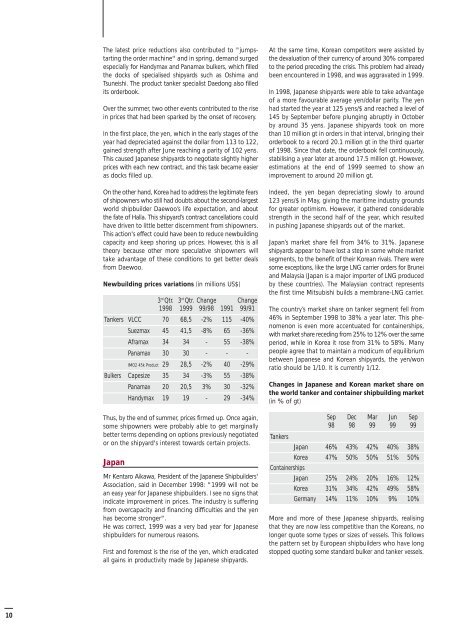You also want an ePaper? Increase the reach of your titles
YUMPU automatically turns print PDFs into web optimized ePapers that Google loves.
10<br />
The latest price reductions also contributed <strong>to</strong> "jumpstarting<br />
the order machine" and in spring, demand surged<br />
especially for Handymax and Panamax bulkers, which filled<br />
the docks of specialised <strong>shipyards</strong> such as Oshima and<br />
Tsuneishi. The product tanker specialist Daedong also filled<br />
its orderbook.<br />
Over the summer, two other events contributed <strong>to</strong> the rise<br />
in prices that had been sparked by the onset of recovery.<br />
In the first place, the yen, which in the early stages of the<br />
year had depreciated against the dollar from 113 <strong>to</strong> 122,<br />
gained strength after June reaching a parity of 102 yens.<br />
This caused Japanese <strong>shipyards</strong> <strong>to</strong> negotiate slightly higher<br />
prices with each new contract, and this task became easier<br />
as docks filled up.<br />
On the other hand, Korea had <strong>to</strong> address the legitimate fears<br />
of shipowners who still had doubts about the second-largest<br />
world shipbuilder Daewoo’s life expectation, and about<br />
the fate of Halla. This shipyard’s contract cancellations could<br />
have driven <strong>to</strong> little better discernment from shipowners.<br />
This action's effect could have been <strong>to</strong> reduce newbuilding<br />
capacity and keep shoring up prices. However, this is all<br />
theory because other more speculative shipowners will<br />
take advantage of these conditions <strong>to</strong> get better deals<br />
from Daewoo.<br />
Newbuilding prices variations (in millions US$)<br />
3rd Qtr. 3rd Qtr. Change Change<br />
1998 1999 99/98 1991 99/91<br />
Tankers VLCC 70 68,5 -2% 115 -40%<br />
Thus, by the end of summer, prices firmed up. Once again,<br />
some shipowners were probably able <strong>to</strong> get marginally<br />
better terms depending on options previously negotiated<br />
or on the shipyard's interest <strong>to</strong>wards certain projects.<br />
Japan<br />
Suezmax 45 41,5 -8% 65 -36%<br />
Aframax 34 34 - 55 -38%<br />
Panamax 30 30 - - -<br />
IMO2 45k Product 29 28,5 -2% 40 -29%<br />
Bulkers Capesize 35 34 -3% 55 -38%<br />
Panamax 20 20,5 3% 30 -32%<br />
Handymax 19 19 - 29 -34%<br />
Mr Kentaro Aikawa, President of the Japanese Shipbuilders'<br />
Association, said in December 1998: "1999 will not be<br />
an easy year for Japanese shipbuilders. I see no signs that<br />
indicate improvement in prices. The industry is suffering<br />
from overcapacity and financing difficulties and the yen<br />
has become stronger".<br />
He was correct, 1999 was a very bad year for Japanese<br />
shipbuilders for numerous reasons.<br />
First and foremost is the rise of the yen, which eradicated<br />
all gains in productivity made by Japanese <strong>shipyards</strong>.<br />
At the same time, Korean competi<strong>to</strong>rs were assisted by<br />
the devaluation of their currency of around 30% compared<br />
<strong>to</strong> the period preceding the crisis. This problem had already<br />
been encountered in 1998, and was aggravated in 1999.<br />
In 1998, Japanese <strong>shipyards</strong> were able <strong>to</strong> take advantage<br />
of a more favourable average yen/dollar parity. The yen<br />
had started the year at 125 yens/$ and reached a level of<br />
145 by September before plunging abruptly in Oc<strong>to</strong>ber<br />
by around 35 yens. Japanese <strong>shipyards</strong> <strong>to</strong>ok on more<br />
than 10 million gt in <strong>orders</strong> in that interval, bringing their<br />
orderbook <strong>to</strong> a record 20.1 million gt in the third quarter<br />
of 1998. Since that date, the orderbook fell continuously,<br />
stabilising a year later at around 17.5 million gt. However,<br />
estimations at the end of 1999 seemed <strong>to</strong> show an<br />
improvement <strong>to</strong> around 20 million gt.<br />
Indeed, the yen began depreciating slowly <strong>to</strong> around<br />
123 yens/$ in May, giving the maritime industry grounds<br />
for greater optimism. However, it gathered considerable<br />
strength in the second half of the year, which resulted<br />
in pushing Japanese <strong>shipyards</strong> out of the market.<br />
Japan’s market share fell from 34% <strong>to</strong> 31%. Japanese<br />
<strong>shipyards</strong> appear <strong>to</strong> have lost a step in some whole market<br />
segments, <strong>to</strong> the benefit of their Korean rivals. There were<br />
some exceptions, like the large LNG carrier <strong>orders</strong> for Brunei<br />
and Malaysia (Japan is a major importer of LNG produced<br />
by these countries). The Malaysian contract represents<br />
the first time Mitsubishi builds a membrane-LNG carrier.<br />
The country’s market share on tanker segment fell from<br />
46% in September 1998 <strong>to</strong> 38% a year later. This phenomenon<br />
is even more accentuated for containerships,<br />
with market share receding from 25% <strong>to</strong> 12% over the same<br />
period, while in Korea it rose from 31% <strong>to</strong> 58%. Many<br />
people agree that <strong>to</strong> maintain a modicum of equilibrium<br />
between Japanese and Korean <strong>shipyards</strong>, the yen/won<br />
ratio should be 1/10. It is currently 1/12.<br />
Changes in Japanese and Korean market share on<br />
the world tanker and container shipbuilding market<br />
(in % of gt)<br />
Sep Dec Mar Jun Sep<br />
98 98 99 99 99<br />
Tankers<br />
Japan 46% 43% 42% 40% 38%<br />
Korea<br />
Containerships<br />
47% 50% 50% 51% 50%<br />
Japan 25% 24% 20% 16% 12%<br />
Korea 31% 34% 42% 49% 58%<br />
Germany 14% 11% 10% 9% 10%<br />
More and more of these Japanese <strong>shipyards</strong>, realising<br />
that they are now less competitive than the Koreans, no<br />
longer quote some types or sizes of vessels. This follows<br />
the pattern set by European shipbuilders who have long<br />
s<strong>to</strong>pped quoting some standard bulker and tanker vessels.


